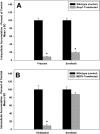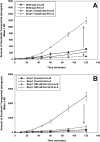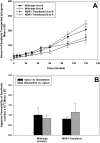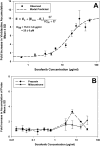The role of the breast cancer resistance protein (ABCG2) in the distribution of sorafenib to the brain
- PMID: 20952483
- PMCID: PMC3014301
- DOI: 10.1124/jpet.110.175034
The role of the breast cancer resistance protein (ABCG2) in the distribution of sorafenib to the brain
Abstract
ATP-binding cassette transporters P-glycoprotein (P-gp) and breast cancer resistance protein (BCRP) have been shown to work in concert to restrict brain penetration of several tyrosine kinase inhibitors. It has been reported that P-gp is dominant in limiting transport of many dual P-gp/BCRP substrates across the blood-brain barrier (BBB). This study investigated the influence of P-gp and BCRP on the central nervous system (CNS) penetration of sorafenib, a multitargeted tyrosine kinase inhibitor currently being evaluated in clinical trials for glioma. In vitro studies showed that BCRP has a high affinity for sorafenib. Sorafenib inhibited P-gp, but did not seem to be a P-gp substrate in vitro. CNS distribution studies showed that transport of sorafenib to the brain was restricted because of active efflux at the BBB. The brain-to-plasma equilibrium-distribution coefficient (area under the concentration-time profiles for plasma/area under the concentration-time profiles for brain) was 0.06 in wild-type mice. Steady-state brain-to-plasma concentration ratio of sorafenib was approximately 0.36 ± 0.056 in the Bcrp1(-/-) mice, 0.11 ± 0.021 in the Mdr1a/b(-/-) mice, and 0.91 ± 0.29 in the Mdr1a/b(-/-)Bcrp1(-/-) mice compared with 0.094 ± 0.007 in the wild-type mice. Sorafenib brain-to-plasma ratios increased on coadministration of the dual P-gp/BCRP inhibitor elacridar such that the ratio in wild-type mice (0.76 ± 0.24), Bcrp1(-/-) mice (1.03 ± 0.33), Mdr1a/b(-/-) mice (1.3 ± 0.29), and Mdr1a/b(-/-)Bcrp1(-/-) mice (0.73 ± 0.35) were not significantly different. This study shows that BCRP and P-gp together restrict the brain distribution of sorafenib with BCRP playing a dominant role in the efflux of sorafenib at the BBB. These findings are clinically relevant to chemotherapy in glioma if restricted drug delivery to the invasive tumor cells results in decreased efficacy.
Figures









Similar articles
-
Insight into the cooperation of P-glycoprotein (ABCB1) and breast cancer resistance protein (ABCG2) at the blood-brain barrier: a case study examining sorafenib efflux clearance.Mol Pharm. 2012 Mar 5;9(3):678-84. doi: 10.1021/mp200465c. Epub 2012 Feb 22. Mol Pharm. 2012. PMID: 22335402 Free PMC article.
-
Distribution of gefitinib to the brain is limited by P-glycoprotein (ABCB1) and breast cancer resistance protein (ABCG2)-mediated active efflux.J Pharmacol Exp Ther. 2010 Jul;334(1):147-55. doi: 10.1124/jpet.110.167601. Epub 2010 Apr 26. J Pharmacol Exp Ther. 2010. PMID: 20421331 Free PMC article.
-
Saturable active efflux by p-glycoprotein and breast cancer resistance protein at the blood-brain barrier leads to nonlinear distribution of elacridar to the central nervous system.J Pharmacol Exp Ther. 2013 Apr;345(1):111-24. doi: 10.1124/jpet.112.199786. Epub 2013 Feb 8. J Pharmacol Exp Ther. 2013. PMID: 23397054 Free PMC article.
-
Recent advances in the in vitro and in vivo methods to assess impact of P-glycoprotein and breast cancer resistance protein transporters in central nervous system drug disposition.Biopharm Drug Dispos. 2023 Feb;44(1):7-25. doi: 10.1002/bdd.2345. Epub 2023 Feb 5. Biopharm Drug Dispos. 2023. PMID: 36692150 Review.
-
O-[11C]methyl derivative of 6,7-dimethoxy-2-(4-methoxy-biphenyl-4-yl-methyl)-1,2,3,4-tetrahydro-isoquinoline.2012 Nov 5 [updated 2013 Jan 31]. In: Molecular Imaging and Contrast Agent Database (MICAD) [Internet]. Bethesda (MD): National Center for Biotechnology Information (US); 2004–2013. 2012 Nov 5 [updated 2013 Jan 31]. In: Molecular Imaging and Contrast Agent Database (MICAD) [Internet]. Bethesda (MD): National Center for Biotechnology Information (US); 2004–2013. PMID: 23390669 Free Books & Documents. Review.
Cited by
-
Screening potential P-glycoprotein inhibitors by combination of a detergent-free membrane protein extraction with surface plasmon resonance biosensor.Acta Pharm Sin B. 2022 Jul;12(7):3113-3123. doi: 10.1016/j.apsb.2022.03.016. Epub 2022 Mar 29. Acta Pharm Sin B. 2022. PMID: 35865104 Free PMC article.
-
Anti-tumor innate immunity activated by intermittent metronomic cyclophosphamide treatment of 9L brain tumor xenografts is preserved by anti-angiogenic drugs that spare VEGF receptor 2.Mol Cancer. 2014 Jun 26;13:158. doi: 10.1186/1476-4598-13-158. Mol Cancer. 2014. PMID: 24965046 Free PMC article.
-
Brain Metastasis Treatment: The Place of Tyrosine Kinase Inhibitors and How to Facilitate Their Diffusion across the Blood-Brain Barrier.Pharmaceutics. 2021 Sep 10;13(9):1446. doi: 10.3390/pharmaceutics13091446. Pharmaceutics. 2021. PMID: 34575525 Free PMC article. Review.
-
The effect of ABCG2 and ABCC4 on the pharmacokinetics of methotrexate in the brain.Drug Metab Dispos. 2014 Apr;42(4):537-40. doi: 10.1124/dmd.113.055228. Epub 2014 Jan 24. Drug Metab Dispos. 2014. PMID: 24464805 Free PMC article.
-
Blood-brain barrier integrity and glial support: mechanisms that can be targeted for novel therapeutic approaches in stroke.Curr Pharm Des. 2012;18(25):3624-44. doi: 10.2174/138161212802002625. Curr Pharm Des. 2012. PMID: 22574987 Free PMC article. Review.
References
-
- Allen JD, van Loevezijn A, Lakhai JM, van der Valk M, van Tellingen O, Reid G, Schellens JH, Koomen GJ, Schinkel AH. (2002) Potent and specific inhibition of the breast cancer resistance protein multidrug transporter in vitro and in mouse intestine by a novel analogue of fumitremorgin C. Mol Cancer Ther 1:417–425 - PubMed
-
- Bailer AJ. (1988) Testing for the equality of area under the curves when using destructive measurement techniques. J Pharmacokinet Biopharm 16:303–309 - PubMed
-
- Begley DJ. (2004) ABC transporters and the blood-brain barrier. Curr Pharm Des 10:1295–1312 - PubMed
-
- Bellmunt J, Eisen T, Fishman M, Quinn D. (2010) Experience with sorafenib and adverse event management. Crit Rev Oncol Hematol doi:10.1016/j.critrevonc.2010,03.006 - DOI - PubMed
Publication types
MeSH terms
Substances
Grants and funding
LinkOut - more resources
Full Text Sources
Other Literature Sources
Miscellaneous

